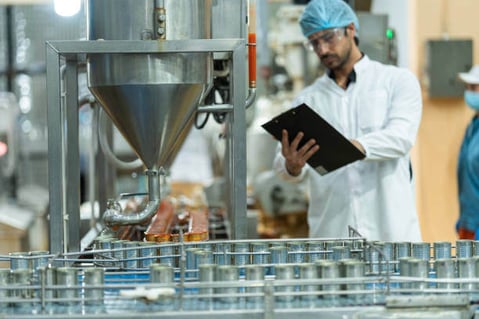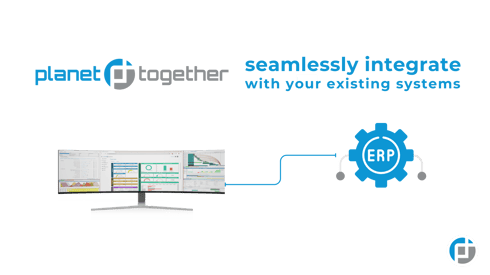Topics: PlanetTogether Software, Integrating PlanetTogether, Real-Time Production Visibility, Scenario Planning and Simulation, Food and Beverage Manufacturing, Centralized Data Synchronization, Automated Updates and Alerts

In food and beverage manufacturing, the ability to forecast demand and production requirements effectively can be the difference between profit and loss, efficiency and waste, customer satisfaction and disappointment. As Manufacturing IT leaders strive to align technology with business outcomes, the integration of Advanced Planning and Scheduling (APS) systems like PlanetTogether with major enterprise solutions such as SAP, Oracle, Microsoft Dynamics, Kinaxis, or Aveva, is becoming a strategic imperative.
This blog explores how Manufacturing IT can champion effective forecasting practices by leveraging integrated APS systems to optimize production planning, minimize downtime, reduce waste, and meet evolving consumer demands.
Forecasting in the food and beverage sector comes with industry-specific challenges:
Short shelf lives and perishability
Rapid shifts in consumer preferences (e.g., plant-based, low-sugar trends)
Seasonal demand fluctuations
Regulatory compliance and traceability needs
High SKU variability due to packaging, flavors, and product lines
These factors demand a forecasting approach that is not only data-driven but also agile and responsive to change. Traditional ERP forecasting modules often fall short in capturing real-time variables and synchronizing production schedules with real-world demand. This is where integrated APS systems provide an edge.

As a Manufacturing IT Manager, your role extends beyond system maintenance — you are a key enabler of strategic digital transformation. By integrating PlanetTogether APS with core enterprise platforms like SAP, Oracle, Microsoft Dynamics, Kinaxis, or Aveva, you can unify data across departments and empower teams with timely, actionable insights.
Centralized Data Synchronization
When PlanetTogether is integrated with ERP platforms like SAP or Oracle, demand forecasts, historical sales data, and supplier lead times can be automatically fed into the APS system. This eliminates data silos and ensures forecasting models are built on the most accurate and current information.
Scenario Planning and Simulation
Integrated systems allow planners to run “what-if” scenarios, adjusting for changes in raw material availability, labor constraints, or demand spikes — a critical capability for the food industry, where even a small disruption can ripple across the entire supply chain.
Real-Time Production Visibility
With Microsoft or Aveva integration, IT can enable plant-wide data collection, monitoring equipment statuses, production rates, and downtime in real time. This feedback loop supports continuous refinement of forecasts based on actual production behavior.
Automated Updates and Alerts
Integration ensures automated forecast updates based on incoming data streams — for instance, new sales orders, returns, or inventory levels. IT can set up custom alerts for threshold breaches, enabling proactive action before issues escalate.
To truly support effective forecasting, IT must build an ecosystem that is:
1. Interoperable
Adopt API-first and middleware approaches to ensure seamless data exchange between PlanetTogether and your chosen ERP or supply chain system.
2. Secure and Compliant
Food and beverage manufacturing is highly regulated. Ensure that all data handling — especially forecasting data that may contain sensitive supplier or customer information — is compliant with relevant standards (e.g., FSMA, GFSI).
3. Scalable
As your product lines and markets grow, forecasting models must evolve. Choose platforms and integration patterns that support modular scaling and AI/ML model expansion.
4. Collaborative
Provide planners, procurement, and production teams with unified dashboards. Tools like Microsoft Power BI, integrated via PlanetTogether’s API layer, can offer visualizations that everyone can act on.
5. Automated
Automate data cleansing, forecast recalculations, and schedule generation wherever possible to reduce human error and increase planning agility.
Effective forecasting is no longer a luxury — it’s a competitive necessity in food and beverage manufacturing. As a Manufacturing IT leader, you have the power to transform how your organization anticipates, plans, and responds to demand. By integrating PlanetTogether APS with leading ERP and supply chain systems like SAP, Oracle, Microsoft, Kinaxis, and Aveva, you not only improve forecast accuracy but also enable a more agile, efficient, and profitable manufacturing operation.
Forecast the future — not with guesswork, but with smart, connected systems.
Are you ready to take your manufacturing operations to the next level? Contact us today to learn more about how PlanetTogether can help you achieve your goals and drive success in your industry.
Topics: PlanetTogether Software, Integrating PlanetTogether, Real-Time Production Visibility, Scenario Planning and Simulation, Food and Beverage Manufacturing, Centralized Data Synchronization, Automated Updates and Alerts
0 Comments







LEAVE A COMMENT